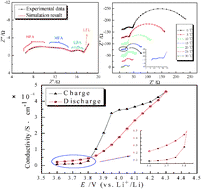Electrochemical and electronic properties of LiCoO2 cathode investigated by galvanostatic cycling and EIS†
Abstract
The processes of

* Corresponding authors
a
Li-ion Batteries Lab, School of Materials Science and Engineering, China University of Mining and Technology, Xuzhou 221116, China
E-mail:
zhuangquanchao@126.com
Fax: +86 516 83591870
Tel: +86 516 83591877
b School of Chemical Engineering and Technology, China University of Mining and Technology, Xuzhou 221116, China
c
State Key Lab of Physical Chemistry of Solid Surfaces, Department of Chemistry, College of Chemistry and Chemical Engineering, Xiamen University, Xiamen 361005, China
E-mail:
sgsun@xmu.edu.cn
The processes of

 Please wait while we load your content...
Something went wrong. Try again?
Please wait while we load your content...
Something went wrong. Try again?
X. Qiu, Q. Zhuang, Q. Zhang, R. Cao, P. Ying, Y. Qiang and S. Sun, Phys. Chem. Chem. Phys., 2012, 14, 2617 DOI: 10.1039/C2CP23626E
To request permission to reproduce material from this article, please go to the Copyright Clearance Center request page.
If you are an author contributing to an RSC publication, you do not need to request permission provided correct acknowledgement is given.
If you are the author of this article, you do not need to request permission to reproduce figures and diagrams provided correct acknowledgement is given. If you want to reproduce the whole article in a third-party publication (excluding your thesis/dissertation for which permission is not required) please go to the Copyright Clearance Center request page.
Read more about how to correctly acknowledge RSC content.
 Fetching data from CrossRef.
Fetching data from CrossRef.
This may take some time to load.
Loading related content
